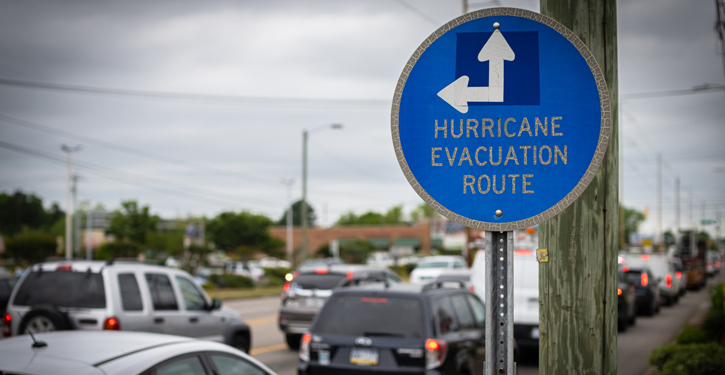Fall has become notorious for hurricanes. Statistically, September is the most active month, but the season stretches from June to November, according to the National Oceanic and Atmospheric Administration (NOAA).
Since 2015, the National Weather Service at NOAA has projected above-average hurricane activity annually. In 2022, NOAA forecasted a range of 14 to 21 named storms with winds of at least 39 mph. Of these storms, between six and ten were expected to become hurricanes with winds exceeding 79 mph, and NOAA anticipated that as many as six could become major hurricanes with winds reaching 111 mph or higher.
It’s essential to take all necessary precautions to stay safe if a hurricane is forecasted for your area, from purchasing insurance to preparing an emergency kit and following evacuation orders. However, some common myths surround hurricane season and the storms it brings. Check out five of the most common below.
1. If I don’t live on the coast, I don’t have to worry
One misconception about hurricanes is that only coastal communities have to worry about impending hurricanes. The truth is even inland homes can be at risk.
Hurricanes can be massive storms, with some spanning 1,000 miles in diameter. Though the storm’s strength decreases when it makes landfall, its destruction often reaches hundreds of miles inland. Storm-surge flooding alone can reach more than 10 miles inland. Heavy rainfall from a hurricane can cause rivers to flood hundreds of miles inland, and coastal storms have even caused significant flooding in the central US, in states like Oklahoma, Missouri, and Kentucky. Hurricanes can also create other weather events, such as thunderstorms and tornados.
2. Opening a window or door will stabilize wind pressure within the home
It’s believed that, during a hurricane, dangerous pressure will build up in a home that can cause severe structural damage, but the theory states that if you open a door or window, this pressure can escape.
The truth is no structure is airtight. The pressure won’t be able to build enough to become dangerous, and the risks of opening a door or window during a hurricane are huge. Rain will pour inside your home, and wind can throw hazardous debris through the opening, potentially causing more damage than if the entry point had been closed.
3. A homeowners insurance policy will cover flood damage from a hurricane
The fact is that most homeowners and renters policies do not cover damage caused by flooding or storm surge from a hurricane.
A standard homeowners policy will cover some, but not all, types of water damage. If the damage occurs suddenly or accidentally and the source is inside your home, such as a burst pipe or faulty water heater, then homeowners insurance will likely provide protection. However, flooding from hurricanes originates outside the home and is most always excluded.
Fortunately, flood insurance exists to fill this gap in coverage. A flood policy can help policyholders recover after damage and loss caused by an overflow of inland or tidal waters, unusual and rapid accumulation or runoff of surface waters, and mudflows.
FEMA reports that one inch of floodwater can cause more than $25,000 in damage. That’s because flooding can damage both your home’s structure and personal belongings. Luckily, flood insurance can protect your foundation, electrical and plumbing, finishings, appliances, electronics, personal belongings, and more.
It’s important to note that there is a mandatory 30-day waiting period before flood coverage goes into effect, so taking action before a storm is key.
4. Evacuations aren’t urgent
A common myth is that there is always plenty of time to evacuate. Some residents also believe in a “wait and see” method, where they linger at home after an evacuation order, thinking the storm won’t be bad enough to warrant evacuating. However, this isn’t always the case.
Even if a mandatory evacuation order hasn’t been issued, evacuating your community well before a hurricane’s arrival is essential. Flooding can begin hours before the storm arrives, and evacuation routes can quickly become congested to the point of shutting down if you delay.
Of course, if possible, you should prepare your home for the storm before you leave. NOAA recommends installing storm shutters over windows and glass doors. If this isn’t possible, you can use plywood. It’s also a good idea to trim hedges and trees to reduce the risk of falling branches and palm fronds, and if you can, clean your gutters.
Just in case, preparing an emergency kit for your family is also a good idea. Ideally, this kit will include nonperishable food, a gallon of water per person per day, flashlights, batteries, and first aid supplies. Generally, it would help if you had enough supplies to last three days. It’s also a good idea to be prepared for power outages, and flashlights are a safer light source than candles during a storm.
5. I don’t have to worry about a category 1 storm
The theory here is that a lower category storm isn’t as much of a threat because hurricane categories are set based on wind speed. Many people assume a hurricane’s potential for damage is its wind speed, but that isn’t always the case.
A hurricane has a lot of potential for damage beyond wind speed. Rainfall, storm surge, and the size of a storm’s wind field aren’t considered when rating a storm, and this can lead to a false sense of security among residents who hear about an upcoming, low-category storm.
At the very least, remember that even a category 1 hurricane can have winds reaching 74-95 mph. Winds alone from category 1 storms have caused damage to roof shingles, vinyl siding, gutters, trees, and power lines. This is in addition to the potential torrential rain and severe storm surge.
Don’t be caught unpreparedPerhaps the biggest myth about hurricanes is that they won’t affect you. More and more places along the Atlantic and further inland communities have been affected by hurricanes.
The best way to prepare is to talk to your Westwood agent. We can help you find the policy that’s right for you. Whether you need to navigate your risk in a hurricane-prone area or need flood insurance for the effects of a hurricane that has drifted to the middle of the country, we can help.
Please Note: This article is for general informational and educational purposes only. It does not represent any specific insurance policy and does not modify any provisions, limitations, or exclusions of any current policy.





